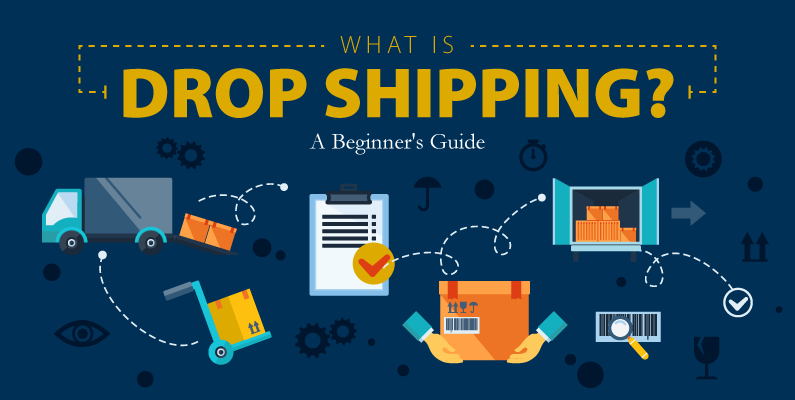Introduction to Dropshipping

- What is Dropshipping?
- Explain the dropshipping business model: selling products online without holding inventory.
- How it works: Customer places an order → You forward the order to the supplier → Supplier ships directly to the customer.
- Why Dropshipping is Popular in 2025:
- Low startup costs compared to traditional businesses.
- No need for warehousing or inventory management.
- Wide range of products available to sell.
- Flexibility to work from anywhere with an internet connection.
- Who Should Start a Dropshipping Business?
- Aspiring entrepreneurs looking for a low-risk business.
- People seeking an additional income stream.
- Individuals interested in eCommerce without technical knowledge.
- Benefits of Dropshipping in 2025:
- Scalability: Easily add more products and scale your business.
- Opportunity to test products and niches without large investments.
- Access to global suppliers and customers.
- Trends Shaping Dropshipping in 2025:
- AI tools for better product research and customer support.
- Increased competition and the importance of finding unique niches.
- Growing focus on fast shipping and local suppliers to improve customer satisfaction.
How to Choose a Profitable Niche

Related Keywords for this Section:
- Best dropshipping niches 2025
- How to find a profitable niche
- Dropshipping product research tips
- Low-competition niches for dropshipping
- High-demand dropshipping products
Key Points to Cover:
- What is a Dropshipping Niche?
- Define what a niche is: A specific segment of a market with distinct customer needs.
- Importance of selecting a niche: Stand out in a competitive dropshipping market by targeting a specific audience.
- Characteristics of a Profitable Niche:
- High Demand: Products that customers need or want consistently.
- Low Competition: Avoid oversaturated niches to maximize profits.
- Good Profit Margins: Products that allow for significant markup.
- Repeat Purchases: Niches with products customers buy frequently (e.g., health supplements, pet supplies).
- Top Dropshipping Niches in 2025:
- Sustainable and eco-friendly products (e.g., reusable items, organic goods).
- Health and wellness (e.g., fitness accessories, massage tools).
- Pet products (e.g., smart pet gadgets, pet grooming tools).
- Home organization and decor.
- Tech gadgets and accessories.
- Tools to Research Profitable Niches:
- Use tools like Google Trends, Ahrefs, and SEMRush to spot trending topics.
- Check online marketplaces like Amazon, eBay, and AliExpress for best-sellers.
- Analyze competitors’ stores and see which products are getting traction.
- How to Validate Your Niche:
- Conduct keyword research to assess search volume and demand.
- Use tools like Facebook Ad Library to check successful ads in your niche.
- Test products by running small-scale ads and tracking customer interest.
- Common Mistakes to Avoid When Choosing a Niche:
- Targeting overly broad niches like “clothing” instead of specific ones like “minimalist activewear.”
- Picking a niche based solely on personal interest without verifying market demand.
- Ignoring logistics: Ensure your niche doesn’t have shipping or legal issues (e.g., restricted items).
Finding Reliable Suppliers

- Why Reliable Suppliers are Critical:
- Explain how suppliers impact your business: product quality, shipping times, and customer satisfaction.
- Risks of unreliable suppliers: delayed orders, low-quality products, and potential customer complaints.
- Top Platforms to Find Suppliers:
- AliExpress: Popular for beginners; wide range of products and global shipping.
- Spocket: Focuses on suppliers from the US and EU for faster shipping.
- CJ Dropshipping: Offers product sourcing, warehousing, and faster processing.
- SaleHoo: A directory of vetted suppliers with access to wholesale prices.
- DSers: Helps automate order fulfillment while integrating with AliExpress suppliers.
- Key Factors to Evaluate Suppliers:
- Shipping Times: Prioritize suppliers who can deliver quickly to your target audience.
- Product Quality: Order samples to check product quality before listing them in your store.
- Supplier Reviews: Check reviews and ratings on platforms like AliExpress or third-party forums.
- Communication: Ensure suppliers are responsive and professional in communication.
- Building a Strong Relationship with Suppliers:
- Communicate your business goals and set clear expectations.
- Place consistent orders to build trust and secure better deals.
- Use tools like WhatsApp, Skype, or email for direct communication with suppliers.
- Red Flags to Watch Out For:
- Suppliers with poor communication or delayed responses.
- Lack of reviews or ratings on the supplier’s profile.
- Hidden fees or unclear pricing structures.
- Suppliers who do not offer tracking for shipments.
- Tips for Long-Term Success:
- Diversify your supplier base to reduce risks if one supplier fails.
- Monitor supplier performance regularly and switch if quality or service declines.
- Stay updated on supplier trends and platforms to find the best deals.
Setting Up Your Online Store

- Choosing the Right eCommerce Platform:
- Shopify: The most popular platform for dropshipping due to its ease of use and integrations.
- WooCommerce: Ideal for WordPress users; highly customizable and budget-friendly.
- BigCommerce: Suitable for larger stores with advanced features.
- Compare costs, features, and scalability for each platform.
- Domain Name and Branding:
- Choose a memorable domain name that aligns with your niche.
- Create a professional logo and consistent branding using tools like Canva or Looka.
- Importance of a branded store to build trust with customers.
- Designing Your Store:
- Use clean, mobile-friendly, and visually appealing themes.
- Highlight your unique selling points (USPs) with banners and taglines.
- Organize your products into categories for easy navigation.
- Add high-quality images and detailed descriptions for each product.
- Essential Pages to Include:
- Homepage: Showcase featured products and promotions.
- Product Pages: Include images, descriptions, pricing, and reviews.
- About Us Page: Share your story to build trust with customers.
- Contact Us Page: Add a contact form, email address, and social media links.
- Policies: Add pages for Shipping, Refunds, and Terms & Conditions.
- Integrating Dropshipping Tools:
- Oberlo (for Shopify): Automates product import and order fulfillment.
- Spocket: Helps source products with fast shipping from US/EU suppliers.
- DSers: Streamlines order processing from AliExpress.
- Zendrop: Offers automation and private labeling options.
- Optimizing for Conversions:
- Add customer reviews and testimonials to build trust.
- Use urgency tactics like countdown timers or limited stock indicators.
- Implement abandoned cart recovery emails and exit pop-ups.
- Ensure fast website loading speeds and mobile responsiveness.
- Testing Before Launch:
- Test your checkout process to ensure a seamless user experience.
- Check for broken links, typos, and proper functionality of all tools.
- Ensure secure payment gateways like PayPal, Stripe, or credit card options are set up.
Marketing and Driving Traffic to Your Store
1 Understanding Your Target Audience:
- Define your ideal customer persona based on your niche.
- Research customer preferences, pain points, and purchasing habits.
- Use tools like Google Analytics and social media insights to refine your audience targeting.
2 Social Media Marketing Strategies:
- Facebook Ads: Run targeted ad campaigns to reach specific audiences based on location, demographics, and interests.
- Instagram Marketing: Use Instagram Stories, Reels, and influencer collaborations to showcase your products visually.
- TikTok Ads and Content: Create engaging short videos to promote trending products.
- Pinterest: Optimize pins for popular search terms in your niche and link back to your store.
3 Search Engine Optimization (SEO):
- Research and include relevant keywords in product descriptions, meta tags, and blog posts.
- Create high-quality blog content related to your niche to attract organic traffic.
- Optimize website loading speed and ensure mobile responsiveness for better rankings.
- Build backlinks through guest blogging, partnerships, or directory listings.
4 Email Marketing:
- Build an email list with pop-ups offering discounts or free shipping for sign-ups.
- Send targeted campaigns for promotions, product launches, and abandoned cart recovery.
- Use segmentation to deliver personalized product recommendations to your audience.
5 Paid Advertising:
- Google Ads: Run shopping and search ads targeting high-intent keywords for your niche.
- Retargeting Ads: Use Facebook Pixel or Google Ads to retarget visitors who didn’t complete purchases.
- Allocate a budget for A/B testing ad creatives, copy, and audiences to optimize ROI.
6 Influencer Marketing:
- Partner with micro-influencers in your niche to promote your products authentically.
- Offer affiliate programs or free products to influencers in exchange for reviews or posts.
- Track the performance of influencer campaigns to measure ROI.
7 Leverage Content Marketing:
- Create how-to videos, tutorials, and guides related to your products.
- Publish blog posts that answer common questions or solve problems for your audience.
- Use user-generated content (UGC), such as customer reviews or photos, to build credibility.
8 Collaborations and Partnerships:
- Team up with complementary brands for giveaways or cross-promotions.
- Create bundle deals featuring products from other businesses in your niche.
9 Analyze and Optimize Performance:
- Use tools like Google Analytics, Facebook Ads Manager, or Shopify Analytics to track traffic and conversions.
- Identify top-performing marketing channels and double down on them.
- Continuously test and improve your marketing strategies to increase ROI.
Managing and Scaling Your Dropshipping Business
- Efficient Order Management:
- Use automated tools like Oberlo, DSers, or Spocket for streamlined order fulfillment.
- Set up systems for tracking orders and monitoring shipping times to ensure timely delivery.
- Regularly communicate with suppliers to stay updated on inventory and potential delays.
- Providing Exceptional Customer Support:
- Offer multiple support channels, such as email, live chat, or social media messaging.
- Respond promptly to customer inquiries and complaints to build trust and loyalty.
- Use tools like Zendesk or Gorgias to manage customer support efficiently.
- Tracking and Analyzing Performance Metrics:
- Monitor key metrics like conversion rate, cart abandonment rate, and return on ad spend (ROAS).
- Use analytics tools like Google Analytics, Shopify reports, or Facebook Ads Manager to gain insights into performance.
- Identify high-performing products and campaigns to replicate their success.
- Expanding Your Product Range:
- Research trending products in your niche to keep your inventory fresh and appealing.
- Test new products by running small-scale ad campaigns to gauge customer interest.
- Gradually add complementary products to encourage upselling and cross-selling.
- Automating and Outsourcing Tasks:
- Automate repetitive tasks like order processing, email marketing, and inventory updates using tools like Zapier or Klaviyo.
- Outsource time-consuming tasks like content creation, ad management, or customer support to freelancers or agencies.
- Scaling Marketing Efforts:
- Increase your advertising budget for high-performing campaigns.
- Explore additional marketing channels, such as Google Ads, influencer marketing, or affiliate programs.
- Retarget existing customers with personalized offers to boost repeat sales.
- Building a Brand Around Your Store:
- Invest in professional branding, including custom packaging, logos, and consistent visual elements.
- Offer branded products or private labeling to stand out from competitors.
- Create a memorable customer experience that encourages referrals and positive reviews.
- Expanding to New Markets:
- Target international markets with localized marketing strategies and language translations.
- Partner with suppliers who can provide faster shipping to new regions.
- Adjust your store’s currency, pricing, and product offerings to cater to different markets.
- Preparing for Seasonal Trends and Scaling:
- Plan for peak seasons like Black Friday, Cyber Monday, and holidays by stocking up on trending products.
- Use data from previous sales periods to predict demand and adjust marketing strategies.
- Offer time-sensitive discounts or bundle deals to maximize seasonal sales.
- Long-Term Business Growth:
- Build an email list and create long-term customer relationships through loyalty programs.
- Invest in content marketing, SEO, and organic traffic to reduce dependency on paid ads.
- Continuously innovate and adapt to changes in market trends and customer behavior.
Common Mistakes and How to Avoid Them

- Choosing the Wrong Niche:
- Mistake: Selecting a niche with too much competition or low demand.
- How to Avoid: Do thorough market research using tools like Google Trends, SEMRush, or AliExpress to validate your niche. Focus on niches with high demand, low competition, and strong profit margins.
- Pro Tip: Test products in a niche before fully committing to ensure there is a market for them.
- Neglecting to Research Suppliers:
- Mistake: Partnering with unreliable suppliers who offer low-quality products or long shipping times.
- How to Avoid: Vet suppliers by checking reviews, ordering sample products, and ensuring they have reliable shipping times. Use trusted platforms like AliExpress, Spocket, or SaleHoo.
- Pro Tip: Always build relationships with multiple suppliers to mitigate risk and maintain a smooth supply chain.
- Ignoring Customer Service:
Mistake: Not providing fast, professional customer support. Poor customer service can lead to negative reviews, chargebacks, and a damaged reputation.
